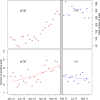Experience of adopting faecal immunochemical testing to meet the NICE colorectal cancer referral criteria for low-risk symptomatic primary care patients in Oxfordshire, UK
- PMID: 31656559
- PMCID: PMC6788275
- DOI: 10.1136/flgastro-2018-101052
Experience of adopting faecal immunochemical testing to meet the NICE colorectal cancer referral criteria for low-risk symptomatic primary care patients in Oxfordshire, UK
Abstract
Objective: To compare the diagnostic performance of guaiac faecal occult blood (gFOB) testing with faecal immunochemical test (FIT) in a low-risk symptomatic primary care population to provide objective data on which to base local referral guidelines.
Design: Stool samples from routine primary care practice sent for faecal occult blood testing were analysed by a standard gFOB method and the HM-JACKarc FIT between January and March 2016. Symptoms described on the test request were recorded. Patients were followed up over 21 months for evidence of serious gastrointestinal pathology including colorectal adenocarcinoma.
Results: In 238 patients, the sensitivity and specificity for colorectal adenocarcinoma detection using gFOB were 85.7% and 65.8%, respectively, compared with 85.7% and 89.2% for FIT. The positive predictive value (PPV) for gFOB was 7.1% and negative predictive value (NPV) was 99.3%. Comparatively, the PPV for FIT was 19.4% and NPV 99.5%. The improved performance of FIT over gFOB was due to a lower false positive rate (10.8 vs 34.2, p≤0.01) with no increase in the false negatives rate. For any significant colorectal disease, the PPV for FIT increased to 35.5% with a reduction in NPV to 95.7%.
Conclusion: In this low-risk symptomatic patient group, the proportion of samples considered positive by FIT was considerably lower than gFOB with the same rate of colorectal adenocarcinoma detection. One in three of those with positive FIT had a significant colorectal disease. This supports National Institute of Health and Care Excellence recommendation that FIT can be reliably used as a triage test in primary care without overburdening endoscopy resources.
Keywords: colorectal cancer; guaiac test; primary care; stool markers.
© Author(s) (or their employer(s)) 2019. No commercial re-use. See rights and permissions. Published by BMJ.
Conflict of interest statement
Competing interests: None declared.
Figures



References
-
- NICE. Suspected cancer: recognition and referral (NG12). London: National Institute for Health and Care Excellence, 2015. - PubMed
-
- UKCCR. Faecal occult blood testing; report of United Kingdom Coordinating Committee on Cancer Research Working Party: UKCCR, 1989.
LinkOut - more resources
Full Text Sources
